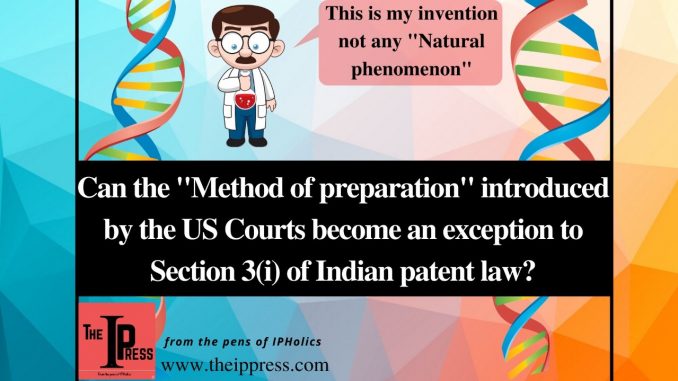
The TRIPS agreement being an International Agreement, sets out for its signatory nations the minimum standards of protection to be provided in respect of the main areas of intellectual property. On the same line, Article 27 of TRIPS prescribes exclusionary provisions for the members to exclude diagnostic, therapeutic and surgical methods for the treatment of humans or animals from patentability. The member nations have more or less adopted the said provision and have brought it into the practice of their own patent laws. Even the Patents Act in India lays down in Section 3(i) that any process for the medicinal, surgical, curative, prophylactic diagnostic, therapeutic or other treatment of human beings or any process for a similar treatment of animals to render them free of disease or to increase their economic value or that of their products is a non-patentable subject matter.
It has been seen that though Section 3(i) has made a blanket exclusion on the above-mentioned processes, the provision has never been intelligibly applied by the stakeholders. Sometimes, patent seekers have taken advantage of the imprecise language of the provision. While other times, the issuing authorities have unnecessarily widened the scope of the same and have applied it quite arbitrarily. In several cases, it has been seen that Applicants cleverly (or strategically as it is their prime task) draft the specification in such a way that the subject matter which should have actually fallen within the ambit of this section, gets acclaimed easily. We can understand this scenario with an example. A patent application claiming a process of treatment of a disease was filed with the Indian patent office and the same was objected under Section 3(i). The same application was then amended to overcome the examiner’s objection by claiming the composition of the medicament for treatment of the same disease, and it was allowed.
Further, a gateway to escape the barriers put forward by this section has been seen and has also been used by many to surpass the test of patentability. The manual of the Patent Office Practice and Procedure defines the process of diagnosis as the identification of the nature of a medical illness, usually by investigating its history and symptoms and by applying tests. Determination of the general physical state of an individual (e.g. a fitness test) is considered to be diagnostic. However, determining the amount of presence of a component in a sample (that may be extracted from human body) or detecting the presence of that component in the sample has often been termed as a detection process and not a diagnostic or treatment process. Therefore, the argument presented by the applicant stating that the claimed method or composition does not relate to a diagnostic or treatment process but to a detection process actually works and so defies the said barricade provision. On a concluding note, it can be said that there is a lot of redundancy, creating several loopholes in the above-discussed provision of Section 3 of the Patents Act.
It seems that India is not the only country evidencing imprecise interpretations of this section. Many other major jurisdictions are also battling the same menace of non settlement of the provision of similar sections in their respective municipal laws. A recent decision of the Federal Circuit (FC) in Illumina v Ariosa Diagnostics is a prime example of the same. The FC, in fact, reversed a trial court’s summary judgement, allowing the claims which were previously found to be claiming a non-patentable subject matter.
The patents in question were US 9580751 and US 9738931 which were related to a cell-free fetal DNA (cffDNA). What was claimed was a solution for overcoming the usual problems in detection of cffDNA. The principle claim of one of the patents is as provided below:
A method, comprising:
(a) extracting DNA comprising maternal and fetal DNA fragments from a substantially cell-free sample of blood plasma or blood serum of a pregnant human female;
(b) producing a fraction of the DNA extracted in (a) by:
(i) size discrimination of extracellular circulatory fetal and maternal DNA fragments, and
(ii) selectively removing the DNA fragments greater than approximately 300 base pairs, wherein the DNA fraction after (b) comprises extracellular circulatory fetal and maternal DNA fragments of approximately 300 base pairs and less and a plurality of genetic loci of the extracellular circulatory fetal and maternal DNA fragments; and (c) analyzing DNA fragments in the fraction of DNA produced in (b).
The trial court found the above subject matter to be non-patentable by holding it to be directed to a natural phenomenon. In appeal, the FC reversed the findings of the trial court by stating that the subject being claimed is directed towards a method of preparing a fraction of cell-free DNA of particular characteristics. This method was held to be a “method of preparation” rather than the specifically barred “natural phenomenon”.
In the present matter, holding the alleged not to be a “natural phenomenon” may seem to be appropriate. However, with this decision of the US court introducing an altogether new category of patentable subject matter, i.e., method of preparation, it is not clear if this category has been introduced to bring clarity regarding the implementation of the provision or as a means to defy the exclusionary provisions. Let us also see if the Indian Patent System gets a clarity regarding the application of the provision of section 3(i) or it creates more disorientation. This can only be ascertained by the decisions of the Patent Office and the Courts in the upcoming cases.

Leave a Reply